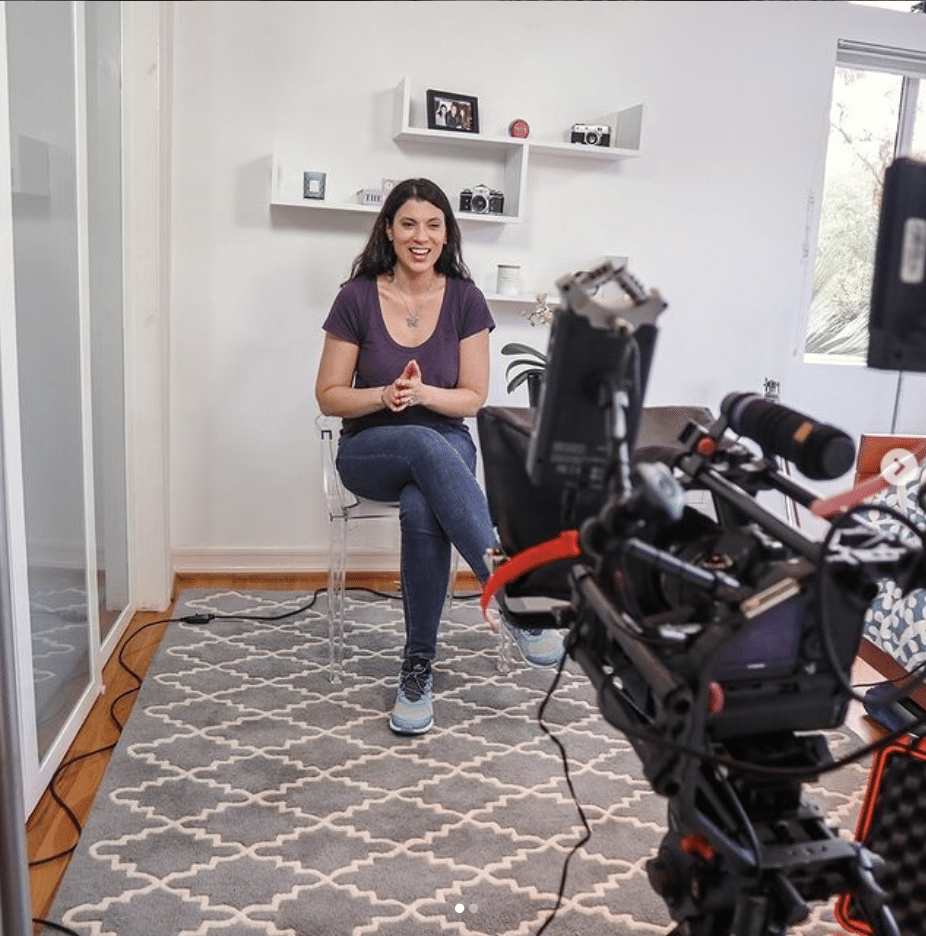I’ve had video confidence since I was a teenager. Back in the day, when my family first bought a video camera (you know, those VHS Panasonic handheld ones), I instantly put myself in front of the lens.
Naturally, this love of being on camera pulled me into the wondrous world of acting, where I spent a good portion of my early 20s trying to “make it big” in Hollywood (where I currently reside).
And let me tell you— all those years of classes and acting gigs have paid off as an entrepreneur. Ten years ago, when I built my first business and started my blog (the one you’re reading now), I knew that video would become unavoidable someday. This was back in 2010 when Facebook had just branched out, Instagram didn’t exist, and YouTube was in its infancy.
Do you remember the first time you thought, “It’s so strange seeing people type out their every thought on these Facebook posts?”
Do you want to attract more clients and boost revenue?
I do. I remember thinking that nothing seemed private anymore and that, eventually, we’d be seeing the inside of people’s everyday lives. Not just through Facebook post rants, but with video.
The writing was on the walls, and as I’m sure you know by now, video is a staple in marketing your personal brand. If your company depends on one-on-one interactions with you (the business owner) then video content will be your ultimate selling point. It’s going to help you intrigue investors, clients, or customers who want to know who you are and what it will be like working with you.
RELATED: PERSONAL BRAND STATEMENT EXAMPLES & TIPS TO CREATE YOUR OWN
How To Increase Video Confidence in 5 Steps
Your time to create video content is coming, and the fear of putting yourself on camera will have to be something you overcome. Remember, as an entrepreneur, it is our job to step outside our comfort zones.
If you’ve been feeling a bit too comfortable in your business endeavors lately, then you’re in the right place. By the end of this blog, you’re going to make the uncomfortable decision to finally start working on your personal brand videos.
Most people do not have the innate ability to be confident on camera. Especially if you’re an older millennial or a Gen Xer— we didn’t grow up with a camera attached to our hip. Reality TV meant watching an episode of Survivor. Whereas now, any video on YouTube, Tik Tok, or even Instagram Stories are essentially bite-sized reality shows.
Today, there are few excuses you can use to explain why you’re not creating videos for your personal brand. Our video recorders fit into our pockets, there are tutorials galore on how to do simple editing, and you can film something as short as 60 seconds for a Tik Tok up to a 30-minute YouTube video.
So why aren’t you creating videos, again?
Oh, that’s right: because being in front of the camera is intimidating as hell.
Don’t worry— your video confidence will go through the roof once you follow my five steps.
RELATED: HOW TO BUILD A REPUTATION WITH YOUR ONLINE PRESENCE
Step 1. Understand Your Equipment
If you want to know how to be confident on camera, you should know that it all starts with your main piece of equipment: your camera.
Whether you’re using your iPhone or a DSLR, knowing your video device is going to cut your film time in half. Plus, it’ll give you the courage to stop procrastinating and step in front of the lens.
The first time you set up your camera to record, you’re going to feel lost. You’ll be asking yourself, “Does this background look professional?; Is this lighting going to work?; What am I going to say?”
Here’s the thing: you should have the answer to all of that before you film a single video.
So step one for video confidence is deciding on your equipment. Let’s assume you’re just using your phone for now. The settings here are pretty straight forward: start record, stop record.
BONUS TIP: Figure out how you’re going to send your videos to your computer for editing. Airdrop is the easiest if you have all Apple products, but you can also use a USB (so make sure you have one!).
And remember that audio is vital to how well your video performs. I recommend a lapel mic (or something a little less conspicuous than AirPods) to ensure people can hear what you’re saying.
Lights, Camera, Action
Next, you need to decide where you’re going to film all of your videos. Have a clean, dedicated space that you can call your own. And have some fun with it! I set up my filming area with cute shelves, a desk, and some eye-catching objects.
You also need to figure out your lighting situation. Natural lighting is the best (free) option, but nowadays, these ring lights are pretty much a staple in everyone’s home.
Now for the hard part: editing software. iMovie is free on MacBooks, but programs like Final Cut are where the magic happens. Final Cut doesn’t have as steep a learning curve as programs like Adobe Premiere Pro.
Any of these three will work for your first batch of videos. If you’re creating shorter form content like Instagram Reels, you can even use apps like Inshot to clip everything together in minutes.
RELATED: 10 YOUTUBE TIPS FOR PERSONAL BRANDS
Step 2. Know Your Strengths
When I told one of my first clients that they needed to have video content, they wanted to know how to look natural on camera.
I was honestly shocked that they asked me. This was a CEO of a major company; surely he had been on camera before?
Come to find out; they had never to be in front of a camera for their company. They relied on the company brand and their customers to get the word out about their services, which meant his personal brand was on the backburner.
Like most of my clients now, they came to me because they wanted to leverage their expertise for more opportunities. So I asked them a simple question:
“What did you bring to the table for your company?”
They instantly named three things they handled in their company or had received praise for from former colleagues.
Those topics became the focus of their video content.
Video confidence doesn’t have anything to do with being an introvert or an extrovert; it’s all about having confidence in yourself and the knowledge you have to give to people.
If you genuinely know your stuff, all you have to do is turn on your camera and record a video explaining what you know. Do it the same way you would to explain to a potential client or customer.
So, pick a few topics you can speak on easily. Then, break those down into smaller categories with things you talk about regularly. Not only will this make you appear more confident in your videos, but it will ensure you never run out of educational content to present to your target audience.
RELATED: 10 THINGS YOU NEED ON YOUR PERSONAL BRAND WEBSITE

Step 3. Write a Script
I don’t know if you can tell from my YouTube videos, but I read from a script. Believe it or not, this comes more naturally to me than if I were to read from an outline on my video topic.
However, not everyone is a trained actress that can remember their script well enough to repeat it verbatim. Because if you’re reading a script word for word, people will probably notice— especially if it’s your first time.
Instead, I recommend writing down your video title and a few bullet points that will guide you through your video. Think of them as talking points you would use if you were to give a presentation.
You can also choose to write down the entire script so that you have an idea of what to say. If you maintain a blog, then most of the work is already done for you because you can repurpose those into short video scripts!
If you think you’re better off reading from a script, I recommend getting a DSLR and a teleprompter to read the words from (you can find a list of my video equipment down at the bottom).

Step 4. Video Confidence Requires Practice
If you want to know how to get comfortable recording yourself, I’m going to reiterate what you already know:
It takes practice.
I will say that recording long-form video content such as IGTVs or YouTube videos requires a lot more video confidence than tapping on Instagram Stories.
For my clients who are video shy, I always recommend that they practice showing up on short-form video content first. Instagram Stories is an excellent option because if you don’t like it, it will disappear in 24 hours!
Reels and Tik Toks only need to be 15-60 seconds long. This makes it easy for you to practice being on video daily, and it helps you with your editing skills. Keep in mind that these are likely to garner more views and followers because this is a new form of video content that both social media platforms are heavily prioritizing.
If you want to get comfortable recording yourself, my suggestion is to start posting daily on Stories, move onto creating daily Reels, and then sit down to record long-form content. YouTube videos and IGTVs are going to serve as the main adversaries for your personal brand because they show people the real you. And if the real you is still a mess in front of the camera, practice getting comfortable making shorter videos first.
“Like most of my clients , they came to me because they wanted to leverage their expertise for more opportunities.”
Step 5. Get Used To Negative Feedback
1-star Google reviews, bad press, and mean comments— these are inevitable if you’re putting yourself on social media.
Considering the whole point of your personal brand is to put yourself out there to establish yourself as a leading authority, you should know now that— at some point— someone is going to leave an infuriating comment about you.
We all get it, and honestly, there’s nothing I can say to make you feel better about it. Suppose you’re not ready to take in that negative feedback and channel it into constructive content. In that case, your video confidence won’t grow, and you’ll never post consistently enough for your videos to make an impact on your brand or your career opportunities.
I’ve already written an entire blog on how to take constructive feedback, but here’s the main takeaway: you have more confidence than the people leaving negative reviews because you’re the one putting yourself out there and making things happen for your career.
And they aren’t.
RELATED: 4 REASONS YOU NEED VIDEO CONTENT MARKETING FOR YOUR PERSONAL BRAND
Extra Tips for Video Confidence
Another trick to feeling more confident on video is to make sure your personal brand is fully present: from the start of filming to uploading the final product on social media.
While video confidence is something that comes with daily practice, but being proud of the content you’ve created encourages you to do it more often. So, make sure you create a YouTube thumbnail template (I use Canva for this), pick out your colors and fonts, and maybe even choose a few staple outfits that make you feel like the best version of yourself.
Another quick hack: Say the same opening and closing lines in all of your videos. This saves you time trying to figure out how to start and establishes a sense of familiarity for your returning viewers (and new audiences who start to binge-watch your videos).
Ultimately, knowing how to get comfortable recording yourself takes time and patience with yourself. That’s why I recommend filming yourself on a daily basis. Even if you don’t put it on social media, having a friend or family member point out what you can do better always helps, too.
And don’t forget: we’re all awkward on camera from time to time. We all have stop words (“uh,” “um,” and “yeah” are some of mine), and we all get tongue-tied now and again.
My Video Recording Equipment:
- Camera
- Video Lights
- Teleprompter
- Microphone
- Video Monitor
- Video Tripod
- Audio Recorder
- Editing Software



